Wish Upon a Little Star,
Inside Sunlight, Eternally Bright....
 One of the greatest mysteries of Pellucidar is its sun.
That sun is a peculiar thing, isn't it? What the hell is it?
How is it burning? What is it burning?
One of the greatest mysteries of Pellucidar is its sun.
That sun is a peculiar thing, isn't it? What the hell is it?
How is it burning? What is it burning?
It's been burning, at least, since the era of dinosaurs,
so you gotta figure minimum 200 million years, and probably lots, lots,
longer. Likely since the beginning of the formation of the hollow
earth.
We know our sun is a gigantic flaming ball of gas (sort
of like Dick Cheney) many times larger than the earth (like Cheney's ego).
Its reactions are atomic fusion, powered by gravity from its immense mass.
 But
Pellucidar’s sun is at most, a few hundred miles across, probably smaller.
That's not enough volume or enough mass under normal circumstances, to
sustain a fusion reaction. Normal rules of stellar physics do not apply.
But, on the other hand, the physical laws of the Universe, like relativity,
have not changed. So what's going on?
But
Pellucidar’s sun is at most, a few hundred miles across, probably smaller.
That's not enough volume or enough mass under normal circumstances, to
sustain a fusion reaction. Normal rules of stellar physics do not apply.
But, on the other hand, the physical laws of the Universe, like relativity,
have not changed. So what's going on?
Pellucidar’s sun is at the geographical centre
of the Earth. That means that it is in a relationship with
the rest of the planet, a stable relationship. Given its position
at the centre, its got to be a gravitational mass of its own, or it would
simply be pulled apart by the surrounding gravity of the hollow Earth.
Looked at from the other side, its stable position at
the centre, and relationship to the planet, suggests that its internal
mass and gravity may well be a nexus, an axis of stability for the
entire planet.
But that doesn't jibe with apparent mass and volume.
To hold itself together, and to play a stabilizing role in the the system,
it needs to be far more massive than its volume suggests.
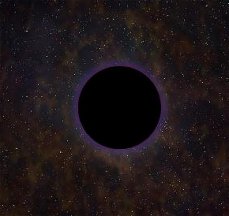 How about this: It's a black hole. Normally, black holes are believed
to be several times the mass of the sun. But science allows for microscopic
mini-black holes. So it's possible that there are intermediate
or tiny 'freak' sizes, of dubious stability. Or, if our physics
don't allow for it, then perhaps there's a tiny wrinkle in the physics
of the Burroughs universe that will produce this celestial object.
How about this: It's a black hole. Normally, black holes are believed
to be several times the mass of the sun. But science allows for microscopic
mini-black holes. So it's possible that there are intermediate
or tiny 'freak' sizes, of dubious stability. Or, if our physics
don't allow for it, then perhaps there's a tiny wrinkle in the physics
of the Burroughs universe that will produce this celestial object.
Drop a black hole into Earth, what happens.
SHLOOMPH!!!! And that's all she wrote. A pretty
short story.
But that's not really the whole story. A black
hole's ability to devour matter is limited to diameter of its event horizon
(the point at which the gravity is so immense that not even light can escape,
it's the point where the black hole goes ‘black.’ After all, matter
has to crowd around it, and cross that event horizon before it can be swallowed.
Which means, it would or could take a comparatively long
time to swallow the entire earth. And what if you weren't actually
on the event horizon, but merely orbiting really fast? An orbital velocity
could stabilize the gravitational pull, leaving you circling the hole just
like any other satellite circles its sun.
 Now,
there was a German physicist named Weizsäcker
(I know the name is suspect, but he was a real person, real mathematics,
real physics), who predicted that if you balanced out rates of spin, you
could wind up with toroid (donut) shaped stable cosmic bodies, like asteroids
or even planets. Burroughs' hollow world is essentially a thin
flat version of a Weizsäcker celestial toroid.
Now,
there was a German physicist named Weizsäcker
(I know the name is suspect, but he was a real person, real mathematics,
real physics), who predicted that if you balanced out rates of spin, you
could wind up with toroid (donut) shaped stable cosmic bodies, like asteroids
or even planets. Burroughs' hollow world is essentially a thin
flat version of a Weizsäcker celestial toroid.
So, let's revisit our hypothetical black hole again.
It falls into primeval Earth about four billion years ago, creates a huge
splash, disrupting the planet. The shock wave and gravitational
effects act like a churn, causing the planet material to spin rapidly.
This causes as much core material to migrate outwards as is devoured by
the core, perhaps the majority of core material is distributed out.
Debris ejected out of the atmosphere eventually coalesces as the moon.
This is only a little more weird than the real theory
of Earth formation currently in vogue. In that theory, the
proto-Earth is struck by a Mars sized planet. The two planets
are shattered, the core of the Mars planet sinks into and merges with the
core of Earth. Earth reforms, but the energy of impact keeps
the core hot and the planet geologically active for billions of years longer
than the other planets of the inner solar system. Venus, Mercury
and Mars are all now geologically dead, their cores having given up their
heat eons ago. Meanwhile, the debris of that impact eventually
coalesced into the Moon, which is a baked, hot dry world without a metallic
core composed of relatively light rock.
As I said, the black hole theory is only a bit weirder
than the real theory, and Burroughs' hollow world is definitely weirder
than our solid world. Still, this would seem to be a one shot
fluke. It's hard to imagine the same process happening with Barsoom
and Amtor. But then again, it's possible that these dwarf black
holes are relatively common at some stages of stellar evolution in Burroughs
universe, and that this is the standard way, over there, that small rocky
inner worlds form. They may all be protective shells around
heavy little dwarf black holes. This may seem bizarre, but
then again, we're finding out that our universe, and the planets and solar
systems we're now discovering seem to be bizarre in their own ways.
Anyway, the black hole then winds up sitting there in
the gravitational centre of the destroyed proto-Earth, at the centre of
the axis of rotation. By virtue of its status as a black hole, wherever
it happens to be, becomes by definition, the centre of the axis of
rotation. Rotation stabilizes an orbital Weizsäcker
shell all around it. At this point, most of the planet's
surviving mass is safely and stabley out of its reach.
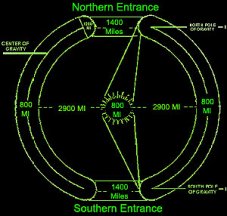 This new Earth, our Earth, forms as a distorted toroid or Weizsäcker
shell, in a stable relationship with the black hole at its centre.
In a weird way, the relationship is not radically different, in Einsteinian
or Newtonian terms, than any other relationship of stellar bodies, such
as that between suns and planets, planets and moons, and double star or
double planet systems.
This new Earth, our Earth, forms as a distorted toroid or Weizsäcker
shell, in a stable relationship with the black hole at its centre.
In a weird way, the relationship is not radically different, in Einsteinian
or Newtonian terms, than any other relationship of stellar bodies, such
as that between suns and planets, planets and moons, and double star or
double planet systems.
The intrinsic gravity of the Weizsäcker shell and
perhaps the additional gravity of the black hole makes for normal
gravity up top.
The intrinsic gravity of the underside, of Pellucidar,
is the same as the topside, of course. But here, on the inside, the
gravity is not bolstered by the black hole, rather, the gravity of the
black hole pulls or counteracts the intrinsic gravity. Thus,
apparent the gravity of Pellucidar may be anywhere from five to fifteen
per cent less than on the surface. No big deal for land and
sea creatures, but murder for flying animals. The ‘tidal’ effects
of the black hole would also tend to accelerate the internal plate tectonics,
which is one of the reasons why geology and geography are moving faster
on the underside (but only in geological terms, its still immensely and
unnoticeably slow by our standards).
Black Holes / Bright Sun?
But here is a problem. Black holes are obviously
black. Light doesn't escape. Pellucidar’s sun is obviously
letting light escape. It provides the heat and light for the inner
world. How does that work? How can a black hole
be a bright sun?
There are a couple of possibilities, neither comforting.
One, is that the 'dwarf' black hole may not be stable, and in fact, may
be degenerating. That is, its physics are no longer sufficient to keep
light escaping, and it is now leaching off its energy. Give it a billion
years or so, and it may reach a point where it goes boom. Or, for all we
know, it might reach that point next Thursday.
In Burroughs universe, the Asteroid belt may well be the
remains of a similar hollow world with a black hole at the centre that
eventually went boom.
But for now, we've had hundreds of millions of years
of stable decay, providing light, warmth and sunshine to the inhabitants
of Pellucidar, and if the end is to come like this in Burroughs universe,
it will, at least, be quick.
Alternatively, if we want to be more exotic, remember
what I said about actually having to cross the event horizon?
Well, gravity is pretty immense just before the event horizon, there's
a lot of mass to get through.
So, what if, as it approaches the event horizon, matter
chokes? There is so much mass, and its packed
so thick, that literally, it can't get through.
Instead of simply devouring all, mass accretes around the black hole, just
outside the event horizon, like a thick shell.
Stray molecules and atoms are constantly falling in, the
shell is permanently disintegrating.
But at the same time, its constantly being added to,
so it appears mostly stable.
All right, so we've got the egg of doom. So what?
Well, here's an interesting thing about black
holes. It turns out, they do radiate. I think its called Cherenkov
radiation. What happens is, that when black holes cross the event horizon,
they're being torn apart, and release a tiny burst of energy just before
they cross. Thus, every particle that crosses over leaves a signature.
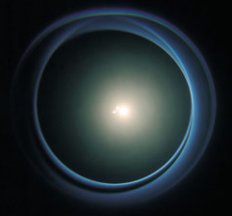
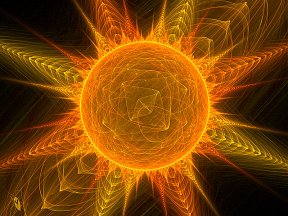
Which then sterilizes every dinosaur and corsair in
Pellucidar? Not quite. All that radiation is then trapped in
the outer shell which acts like lead shielding. The vast amount of released
energy is trapped, degrading until it finally escapes as heat and
light.... Pellucidar’s sun.
Further, matter doesn't simply fall straight in, but spirals
in, in a deteriorating orbit. The closer it gets, the faster
it goes. Just outside the event horizon, particles may be approaching
light speed, and in doing so, releasing large amounts of energy.
Energy that is trapped in the shell and escapes as heat and light.
Of course, certain kinds of energy or force will reach
beyond the shell. Gravity, of course, is one factor.
Electromagnetic energy is another, the spinning black hole in its shell
generates the planetary magnetic field. We know that Quasars
release radiation or radio waves from its polar axis, this likely occurs
here between the shell and the black hole. But because the
black hole is permanently oriented on Earth's axis, these bursts of radiation
and radio simply go through the poles, where the energy illuminates the
aurora borealis.
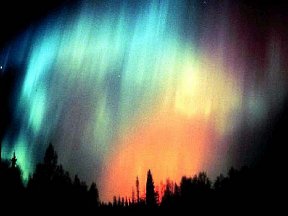
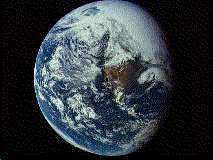 The net result is that we've got a local cosmology almost
similar to Plato's theory of a Universe composed of shells within shells.
We have the outer world, the intervening layer, the inner world, the inner
world atmosphere, the 'shell' of the sun and the black hole at the centre.
The net result is that we've got a local cosmology almost
similar to Plato's theory of a Universe composed of shells within shells.
We have the outer world, the intervening layer, the inner world, the inner
world atmosphere, the 'shell' of the sun and the black hole at the centre.




![]()
![]()
![]()
![]()

![]()